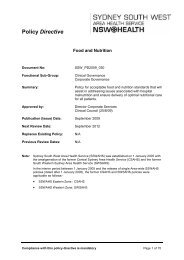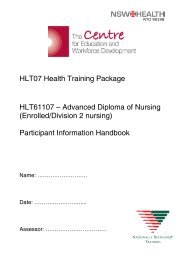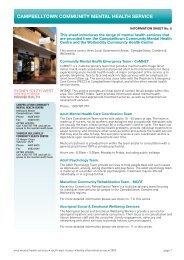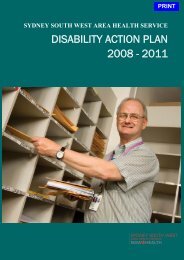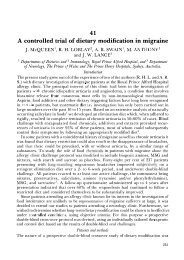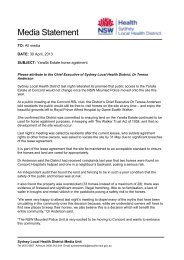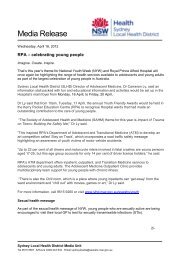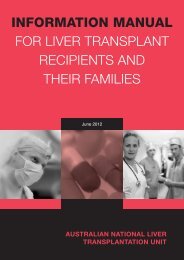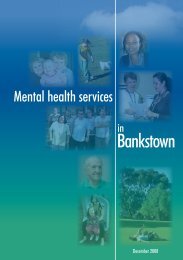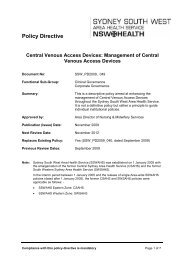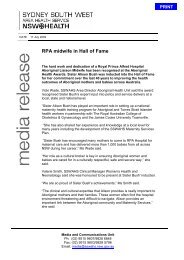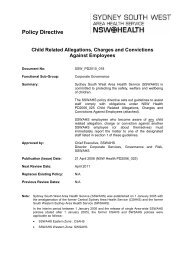Aged Care & Rehabilitation Clinical Services Plan 2007 – 2012
Aged Care & Rehabilitation Clinical Services Plan 2007 – 2012
Aged Care & Rehabilitation Clinical Services Plan 2007 – 2012
Create successful ePaper yourself
Turn your PDF publications into a flip-book with our unique Google optimized e-Paper software.
<strong>Aged</strong> <strong>Care</strong> & <strong>Rehabilitation</strong> <strong>Clinical</strong> Service <strong>Plan</strong> <strong>2007</strong> - <strong>2012</strong>respectively for the year, calculated at 85% occupancy. The high average length of stay (ALOS) atCamden is likely to reflect the transfer of long stay patients from Campbelltown Hospital.Liverpool Hospital has a 20 bed acute geriatric ward. In 2004/05, 33 beds at 85% occupancy wereutilised by these patients. At any stage, between 15 and 30 patients have active rehabilitationissues. A number of these patients would benefit from being colocated, with an emphasis on arehabilitation milieu, whilst at the same time having their acute medical needs met at LiverpoolHospital.Bankstown-Lidcombe Hospital does not have a general medicine unit, with geriatricians providingthe general medicine service. This shared service, along with shared aged care/aged carepsychiatry wards, make analysis of activity data for geriatric medicine difficult. The data indicates alarge number of outliers are being treated by geriatricians, with 27 beds outside of the agedcare/aged care psychiatry wards utilised. Bankstown-Lidcombe Hospital also runs a 40 bedrehabilitation unit (including 8 designated stroke beds). Activity in 2004/05 utilised 55 beds.RPAH operated a maximum of 28 acute aged care beds in 2004/05, including winter beds. In2004/05, 34 beds were occupied by acute geriatric and general medicine patients. It is not possibleto disaggregate general medicine from acute geriatric patients in this total bed analysis.Balmain Hospital operates as a stand alone 78 bed geriatric and rehabilitation facility. Patients aretransferred from RPAH to Balmain, predominantly for sub-acute and rehabilitative care. Activity atBalmain Hospital in 2004/05 indicates that 70 beds were required. However, with the changes toacute beds at RPAH, these additional beds are likely to be fully utilised in 2005/06.The CRGH service has a complex service role, incorporating acute and sub-acute aged care, andrehabilitation. The geriatricians also provide general medicine. Until 2005/06 there were nodesignated rehabilitation beds and as such rehabilitation activity is fairly low. In 2004/05, there were88 aged care and general medicine beds at CRGH, however activity suggested the need for 96beds, plus another 5 beds for rehabilitation (totally 101 beds). The development of the 15 bedrehabilitation unit in 2005/06, meets the additional bed requirements at present.Canterbury Hospital operates a general medicine service and an acute and sub-acute aged careservice. Beds are located in shared wards. Current activity in geriatrics suggests that 28 beds, oressentially a designated ward, were required in 2004/05.Average length of stay (ALOS) for patients varies across the hospitals, and is difficult to break downdue to the combination of patients within the data presented. However, it is evident thatrehabilitation patients generally stay for between 20 and 30 days, and aged care patients staybetween 8 and 16 days, depending on their level of acuity. Whilst changes to models of care andother improvements may enable a less variable length of stay to be achieved, clinicians indicate thatlength of stay is unlikely to be greatly reduced, given the ageing population and increasing frailty ofmost patients.Current and Emerging Issues• Population ageing – the increasing number of older people will result in increasing demand forAC&RS beds;• Prevalence of dementia – people with dementia are known to have a four times longer lengthof stay in hospital than older people without dementia. A high proportion of aged care inpatientsalso experience delirium. Improvements to ward environments and staffing may assist inreducing this length of stay;• Younger people with a disability – AC&RS inpatients include younger people with a disability.Some will have ongoing guardianship issues, delaying appropriate discharge;• Emerging models of care – the delivery of community based services for the treatment ofchronic illness, and alternative settings for the delivery of therapy services, may reduce inpatientdemand;• People with complex discharge needs – many AC&RS patients require the coordination of anarray of community services before they can go home, including home modifications and supportservices;• Patients requiring residential aged care placement – a number of patients in each facility willbe awaiting placement in a residential care facility, but for various reasons have not yet beendischarged;Page 52




